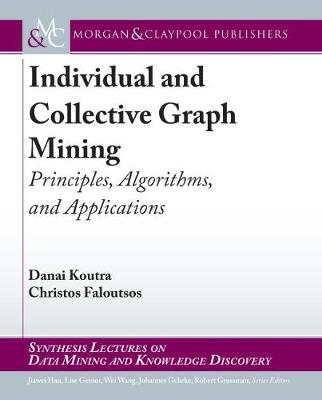Synthesis Lectures on Data Mining and Knowledge Discovery
2 total works
What does the Web look like? How can we find patterns, communities, outliers, in a social network? Which are the most central nodes in a network? These are the questions that motivate this work. Networks and graphs appear in many diverse settings, for example in social networks, computer-communication networks (intrusion detection, traffic management), protein-protein interaction networks in biology, document-text bipartite graphs in text retrieval, person-account graphs in financial fraud detection, and others.
In this work, first we list several surprising patterns that real graphs tend to follow. Then we give a detailed list of generators that try to mirror these patterns. Generators are important, because they can help with ""what if"" scenarios, extrapolations, and anonymization. Then we provide a list of powerful tools for graph analysis, and specifically spectral methods (Singular Value Decomposition (SVD)), tensors, and case studies like the famous ""pageRank"" algorithm and the ""HITS"" algorithm for ranking web search results. Finally, we conclude with a survey of tools and observations from related fields like sociology, which provide complementary viewpoints.
In this work, first we list several surprising patterns that real graphs tend to follow. Then we give a detailed list of generators that try to mirror these patterns. Generators are important, because they can help with ""what if"" scenarios, extrapolations, and anonymization. Then we provide a list of powerful tools for graph analysis, and specifically spectral methods (Singular Value Decomposition (SVD)), tensors, and case studies like the famous ""pageRank"" algorithm and the ""HITS"" algorithm for ranking web search results. Finally, we conclude with a survey of tools and observations from related fields like sociology, which provide complementary viewpoints.
Individual and Collective Graph Mining
by Danai Koutra and Christos Faloutsos
Published 26 October 2017
Graphs naturally represent information ranging from links between web pages, to communication in email networks, to connections between neurons in our brains. These graphs often span billions of nodes and interactions between them. Within this deluge of interconnected data, how can we find the most important structures and summarize them? How can we efficiently visualize them? How can we detect anomalies that indicate critical events, such as an attack on a computer system, disease formation in the human brain, or the fall of a company?
This book presents scalable, principled discovery algorithms that combine globality with locality to make sense of one or more graphs. In addition to fast algorithmic methodologies, we also contribute graph-theoretical ideas and models, and real-world applications in two main areas:
•Individual Graph Mining: We show how to interpretably summarize a single graph by identifying its important graph structures. We complement summarization with inference, which leverages information about few entities (obtained via summarization or other methods) and the network structure to efficiently and effectively learn information about the unknown entities.
•Collective Graph Mining: We extend the idea of individual-graph summarization to time-evolving graphs, and show how to scalably discover temporal patterns. Apart from summarization, we claim that graph similarity is often the underlying problem in a host of applications where multiple graphs occur (e.g., temporal anomaly detection, discovery of behavioral patterns), and we present principled, scalable algorithms for aligning networks and measuring their similarity.
The methods that we present in this book leverage techniques from diverse areas, such as matrix algebra, graph theory, optimization, information theory, machine learning, finance, and social science, to solve real-world problems. We present applications of our exploration algorithms to massive datasets, including a Web graph of 6.6 billion edges, a Twitter graph of 1.8 billion edges, brain graphs with up to 90 million edges, collaboration, peer-to-peer networks, browser logs, all spanning millions of users and interactions.
This book presents scalable, principled discovery algorithms that combine globality with locality to make sense of one or more graphs. In addition to fast algorithmic methodologies, we also contribute graph-theoretical ideas and models, and real-world applications in two main areas:
•Individual Graph Mining: We show how to interpretably summarize a single graph by identifying its important graph structures. We complement summarization with inference, which leverages information about few entities (obtained via summarization or other methods) and the network structure to efficiently and effectively learn information about the unknown entities.
•Collective Graph Mining: We extend the idea of individual-graph summarization to time-evolving graphs, and show how to scalably discover temporal patterns. Apart from summarization, we claim that graph similarity is often the underlying problem in a host of applications where multiple graphs occur (e.g., temporal anomaly detection, discovery of behavioral patterns), and we present principled, scalable algorithms for aligning networks and measuring their similarity.
The methods that we present in this book leverage techniques from diverse areas, such as matrix algebra, graph theory, optimization, information theory, machine learning, finance, and social science, to solve real-world problems. We present applications of our exploration algorithms to massive datasets, including a Web graph of 6.6 billion edges, a Twitter graph of 1.8 billion edges, brain graphs with up to 90 million edges, collaboration, peer-to-peer networks, browser logs, all spanning millions of users and interactions.

